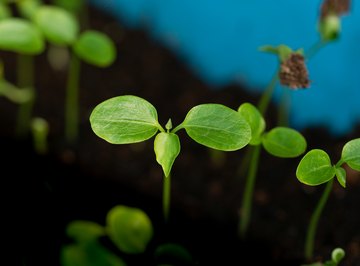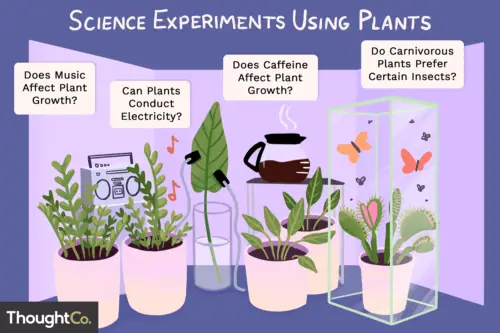The best plant to grow for a science project is fast-growing and easy to observe, such as radishes, bean plants, or sunflowers. These plants require minimal care and can show visible growth within a short period of time.
When choosing a plant for your science project, consider the time frame, available space, and the requirements of the experiment. It’s important to select a plant that aligns with the objectives of your project and allows for clear and measurable observations.
By choosing the right plant for your science project, you can create an engaging and informative experiment that effectively demonstrates key scientific concepts. We will explore the top plant options for science projects and provide tips for successful experimentation.

Credit: mysweetgreens.com
1. Easy And Visual Plants
When embarking on a science project, choosing the right plant is crucial for success. One key factor to consider is opting for easy-to-grow plants that showcase visual appeal, making the project engaging and informative. Below, we explore some top choices under the category of 1. Easy and Visual Plants:
1.1 Fast-growing Plants
To kickstart your science project with efficiency, fast-growing plants are an ideal choice. These plants exhibit rapid growth, enabling you to observe and document changes swiftly. Examples include sunflowers, radishes, and marigolds.
1.2 Plants With Colorful Flowers
Plants with colorful flowers add vibrancy to your project, capturing attention and enhancing the visual appeal. Consider options like zinnias, petunias, and pansies for a splash of color in your science experiment.

Credit: sciencing.com
2. Plants With Interesting Properties
2. Plants with Interesting Properties
When selecting a plant for a science project, it’s important to consider ones with fascinating properties. These plants not only captivate the imagination but also provide valuable insights into the natural world. Here are some intriguing options to consider:
2.1 Carnivorous Plants
Carnivorous plants are a unique and captivating choice for a science project due to their fascinating ability to trap and digest insects. The Venus flytrap, for example, is known for its rapid closure when triggered by the slightest touch. This remarkable mechanism is a prime example of nature’s ingenuity. Other carnivorous plants such as pitcher plants and sundews also offer an opportunity for students to observe and understand the intricate interactions between plants and their prey.
2.2 Sensitive Plants
Sensitive plants, also known as mimosa or touch-me-not plants, exhibit a remarkable response to touch. Their leaves fold inward when they are touched or exposed to certain stimuli, providing an engaging opportunity for students to explore plant sensitivity and responsiveness. This unique characteristic offers a hands-on experience for young scientists to observe and investigate the mechanisms behind this intriguing behavior.
3. Plants For Environmental Studies
Looking for the best plant to grow for a science project? These plants are ideal for environmental studies, providing valuable insights into the natural world.
Start of the section 3. Plants for Environmental StudiesUnderstanding the impact of plants on the environment is crucial for many science projects. Some plants are particularly valuable for studying their effects on air quality and water systems. Let’s explore the top plants for these environmental studies.
3.1 Air Purifying Plants
Air purifying plants are excellent choices for science projects that focus on air quality. These plants have the remarkable ability to remove toxins and purify the air, making them ideal for conducting experiments on indoor air quality. Plants such as pothos, spider plants, and peace lilies are known for their air purifying properties, allowing students to delve into the effects of plants on indoor air pollution.
3.2 Water-hardiness Plants
For projects centered around water systems, water-hardy plants are essential. These plants can thrive in various water conditions and are ideal for studying the effects of different water qualities on plant growth. Species including water lilies, marsh marigolds, and cattails are excellent choices for such studies, providing students with the opportunity to explore the impact of water quality on plant development.

Credit: www.thoughtco.com
4. Plants For A Botany Focus
When it comes to choosing plants for a botany-focused science project, consider focusing on diverse and intriguing categories. Here, we will explore two captivating categories: Medicinal Plants and Rare or Endangered Plants.
4.1 Medicinal Plants
- Certain plants possess healing properties.
- Common examples include aloe vera and lavender.
- Perfect for studying the science of natural remedies.
4.2 Rare Or Endangered Plants
- Endangered plants need special attention for preservation.
- Consider plants like Pitcher Plants or Ghost Orchids.
- Great opportunity to learn about conservation efforts.
5. Plants For Agricultural Experiments
Discover top plant options perfect for agricultural experiments; choose plants like peas, beans, or lettuce for an engaging science project. These plants are ideal for hands-on learning and observing scientific principles in action. Ideal choices for students to delve into the world of plant science.
When it comes to conducting a science project related to agriculture, choosing the right plants is crucial. Planting different varieties allows students to explore various aspects of agriculture, such as high-yield crops and pest-resistant traits. In this section, we will discuss two important categories of plants suitable for agricultural experiments: High-Yield Crop Plants and Plants with Pest-Resistant Traits.5.1 High-yield Crop Plants
High-yield crop plants are species that produce a large quantity of crops per unit area, making them essential in modern agriculture. These plants can be grown in controlled environments or in fields to compare their productivity. Here are some high-yield crop plants that are ideal for science projects: 1. Rice (Oryza sativa): Rice is the staple food for more than half of the world’s population. It is a versatile crop that can be grown in both flooded and upland conditions, making it suitable for various experiments. 2. Maize (Zea mays): Maize, or corn, is one of the most widely cultivated crops globally. It is known for its high productivity and nutritional value. Growing maize can provide students with insights into its growth patterns and different cultivars. 3. Wheat (Triticum aestivum): Wheat is a major cereal crop and the staple food in many regions. By growing wheat in their experiments, students can analyze factors that affect its growth, such as temperature, moisture, and nutrient availability.5.2 Plants With Pest-resistant Traits
Pest-resistant plants possess natural defenses against common agricultural pests. These plants showcase unique traits that help them withstand attacks and reduce the need for chemical interventions. Here are some plant species with pest-resistant traits suitable for science projects: 1. Marigold (Tagetes spp.): Marigolds are known for their bright flowers, but they also have pest-repellent properties. They release a natural compound called limonene, which deters insects and nematodes, making them an excellent choice for experiments focusing on pest control. 2. Basil (Ocimum basilicum): Basil is not only a popular culinary herb but also exhibits natural pest-resistance. Its strong aroma and essential oils repel insects such as mosquitoes and flies. Growing basil can help students explore its effects on pest control in an agricultural setting. 3. Soybean (Glycine max): Soybeans contain compounds called isoflavones that act as natural insecticides. These compounds repel common pests like aphids and caterpillars. By studying soybean plants, students can investigate the mechanisms behind their pest-resistant traits. In conclusion, when choosing plants for agricultural experiments, considering high-yield crop plants and those with pest-resistant traits can provide valuable insights. Students can learn about crop productivity and the natural defenses plants use to combat pests, contributing to the advancement of agricultural practices. So, let’s get started with these fascinating plant experiments!Frequently Asked Questions Of Best Plant To Grow For Science Project?
What Is The Easiest Plant To Grow For A Science Project?
The easiest plant to grow for a science project is the fast-growing bean plant. It requires minimal care and shows noticeable growth within a short period, making it ideal for classroom experiments. With its simple needs and rapid development, it provides an excellent learning experience for students.
What Type Of Seed Grows The Fastest Science Project?
The type of seed that grows the fastest for a science project is the green bean seed. It is commonly used in school experiments due to its rapid germination and growth. This type of seed provides a quick and visible demonstration of plant growth for educational purposes.
Which Plant Is Best For Research?
The Arabidopsis thaliana plant is commonly used for research due to its small size and fast growth rate.
What Are The Easiest Plants To Grow In A Classroom?
The easiest plants to grow in a classroom are spider plants, pothos, and succulents. These plants require minimal care, thrive in moderate lighting conditions, and can withstand occasional neglect. They are perfect for introducing students to the joy of nurturing and caring for plants.
Conclusion
For your science project, consider growing the versatile basil plant. It offers diverse experiments, easy care, and educational value. The aromatic herb’s growth stages fascinate students and provide ample research opportunities. Choose basil for an engaging and rewarding plant-based project that combines science and fun seamlessly.
